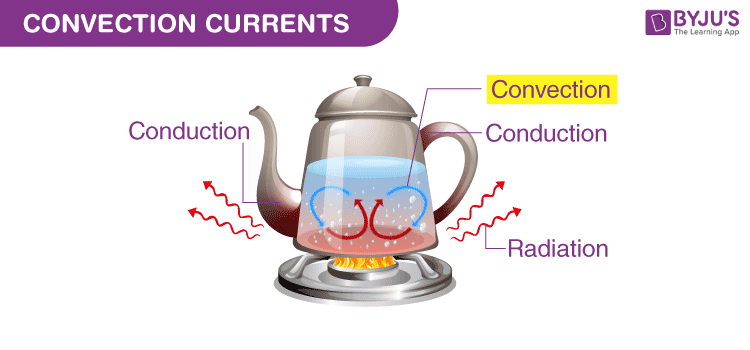A convection current is a process that involves the movement of energy from one place to another. It is also called convection heat transfer. What is the reason that makes you feel hotter when placing your hands above a campfire or when sitting next to it? Or, why is the movement of liquid so rapid when water is boiled in a pot? These things happen as a result of the Convection Currents.
differences occurring within the densities and temperature of a specific gas or a fluid.

Convection currents tend to move fluid or gas particles from one place to another. These are created as a result of the differences occurring within the densities and temperature of a specific gas or fluid. Convection is one of the forms of heat transfer, of which the other two are radiation and conduction. The convection process only happens in fluids, i.e. in liquids and gases. This happens due to the reason that molecules within liquids or gases are free to move.
The heat energy can be transferred by the process of convection by the difference occurring in temperature between the two parts of the fluid. Due to this temperature difference, hot fluids tend to rise, whereas cold fluids tend to sink. This creates a current within the fluid called a convection current.
The mantle within the earth’s surface flows due to convection currents. These currents are mainly caused by a very hot material present in the deepest part of the mantle, which rises upwards, then cools, sinks, again and again, repeating the same process of heating and rising.
Hence, convection current is defined as “a process of continuous heating up of liquids or gases by the process called convection. “
Read More: Heat Transfer by Convection
Convection Currents- Examples
- Boiling of Water– When boiling water on a stove or while making tea, or while boiling an egg. The temperature of molecules within those liquids increases, and they slowly begin to move at a rapid rate. These molecules get charged up, thus producing kinetic energy. These hot water molecules residing near the heat source tend to become less dense. They rise above cooler dense molecules. As these hotter molecules rise, they tend to cool down and begin to sink, replacing cooler molecules. These movements occurring within this boiling water what the convection currents.
- Campfires– The hotness which we feel around a campfire is all that convection currents heating up your hand. Heat comes from various kinds of heat transfers, such as radiation. But while placing your hand above a campfire, a lot of convection currents rises towards you.
- Changes in the weather- The cool air and breeze occurring near to a beach are all the effects of convection currents. The weather changes on a daily basis are also affected by these currents.
- Convection currents occurring in the ocean– The Oceanic currents are also the convection currents. These are caused due to the difference in the water density and the temperature occurring in different parts of the ocean.
- Convection currents are present in the air– A good example of convection current is the warm air that rises towards the ceiling in your house. The process happens as the warm air is said to be less dense than that of the colder air. Another good example of convection current is wind. The wind is mainly caused when the reflected radiation of the light from the sun heats up the air, thus displacing the cooler air.
Watch the video and learn about convection currents


thanks
Welcome!
thank you i like it